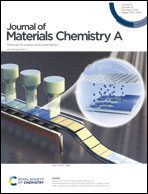Revisiting the role of Zr doping in Ni-rich layered cathodes for lithium-ion batteries†
Abstract
The realization of high performance Ni-rich layered cathodes remains a challenge because of the multiple degradation factors that concurrently operate during battery cycling. In particular, depletion of oxygen charge and consequent lattice-oxygen instability at deep charge state accelerate the subsequent chemomechanical degradation mechanisms. Among the proposed methodologies, doping has proven to be effective in enhancing the cathode cycle life by stabilizing the layered structure. Herein, we achieved the electrochemically stabilized Ni-rich LiNi0.92Co0.04Mn0.04O2 through Zr doping, resulting in a 15% increase of the capacity retention after 100 cycles. In-depth investigations are conducted to unveil the effects of Zr doping on the layered cathode, and in particular, the critical role of Zr doping on the lattice oxygen stability is systematically studied. By combining state-of-the-art magnetometer characterization, X-ray analysis, and first-principles calculation, we reveal that Zr doping positively contributes the to lattice oxygen stability by alleviating the oxygen charge loss at deep charge, thereby improving the cathode electrochemical reversibility. Our findings provide an insight into the Zr doping mechanism and help to design Ni-rich layered oxides for future applications.



 Please wait while we load your content...
Please wait while we load your content...